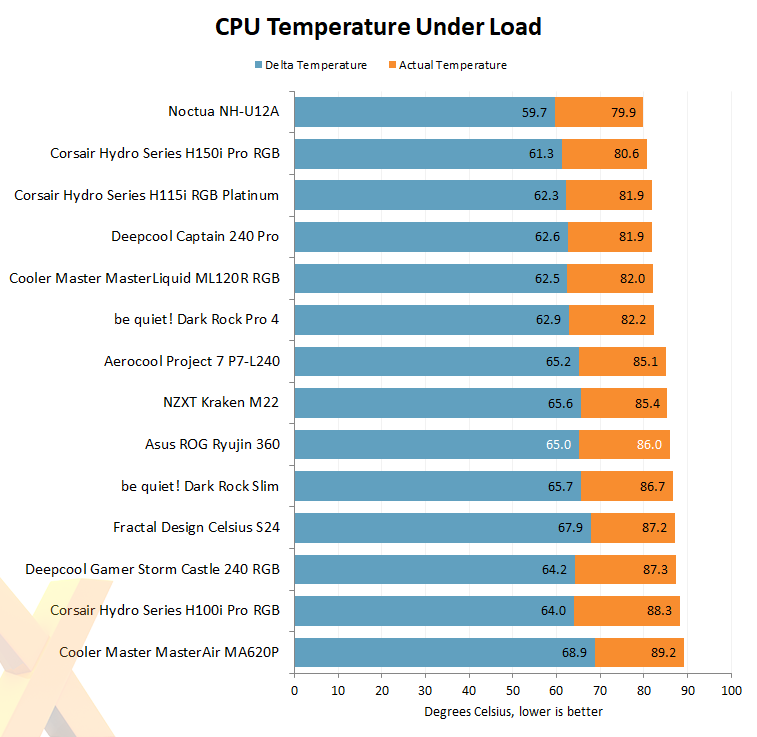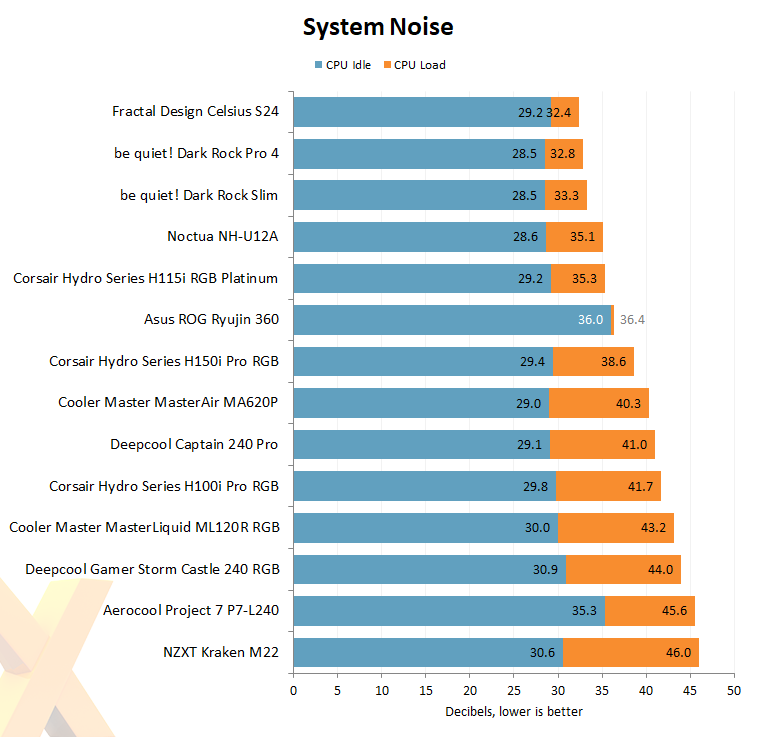Test Methodology and Performance
Comparison Coolers |
|||||
|---|---|---|---|---|---|
| Category | Model | HEXUS Review | Reviewed Price | Warranty | Product Page |
| Air | be quiet! Dark Rock Pro 4 | April 2018 | £80 | 3 Years | bequiet.com |
| be quiet! Dark Rock Slim | May 2019 | £55 | 3 Years | bequiet.com | |
| Cooler Master MasterAir MA620P | March 2018 | £75 | 2 Years | coolermaster.com | |
| Noctua NH-U12A | May 2019 | £90 | 6 Years | noctua.at | |
| Liquid | Aerocool Project 7 P7-L240 | February 2018 | £100 | 2 Years | aerocool.com.tw |
| Asus ROG Ryujin 360 | May 2019 | £232 | 3 Years | asus.com | |
| Cooler Master MasterLiquid ML120R RGB | May 2018 | £100 | 2 Years | coolermaster.com | |
| Corsair Hydro Series H100i Pro RGB | July 2018 | £110 | 5 Years | corsair.com | |
| Corsair Hydro Series H115i RGB Platinum | November 2018 | £140 | 5 Years | corsair.com | |
| Corsair Hydro Series H150i Pro RGB | January 2018 | £165 | 5 Years | corsair.com | |
| Deepcool Captain 240 Pro | January 2019 | £150 | 3 Years | gamerstorm.com | |
| Deepcool Gamer Storm Castle 240 RGB | July 2018 | £96 | 3 Years | gamerstorm.com | |
| Fractal Design Celsius S24 | May 2017 | £105 | 5 Years | fractaldesign.com | |
| NZXT Kraken M22 | March 2018 | £90 | 3 Years | nzxt.com | |
HEXUS CPU Cooler Test Bench |
||
|---|---|---|
| Hardware Components | Product Page | |
| Processor | Intel Core i7-8700K (overclocked to 4.8GHz) | intel.com |
| Motherboard | Asus ROG Maximus X Hero | asus.com |
| Graphics Card | MSI GeForce GTX 1080 Ti Gaming X Trio | msi.com |
| Memory | G.Skill Trident Z 32GB (2x16GB) DDR4-3200 | gskill.com |
| Power Supply | be quiet! Dark Power Pro 11 1,000W | bequiet.com |
| Primary Storage | 256GB WD Black PCIe SSD | wdc.com |
| Secondary Storage | 1TB Crucial MX300 SATA SSD | crucial.com |
| Chassis | be quiet! Dark Base 700 | bequiet.com |
| Monitor | iiyama ProLite X4071UHSU-B1 | iiyama.com |
| Operating system | Windows 10 Pro | microsoft.com |
Benchmark Process
Our test platform was last refreshed in 2018 and includes a hexa-core Intel Core i7-8700K processor overclocked using 1.225v to 4.8GHz across all cores. The 12-thread chip is paired to 32GB of dual-channel G.Skill Trident Z DDR4 memory set to run at 3,200MHz using the built-in XMP profile.
To get a feel for how the coolers compare, CPU temperature is logged while a large 4K video clip is encoded in multiple passes using the freeware HandBrake utility. The workload tasks all available threads for a prolonged period and, in order to provide a stabilised reading, we then calculate the average temperature across all cores from the last five minutes of encoding.
Actual CPU temperature is recorded and we also graph the delta temperature - that's CPU temperature minus ambient temperature. Last but not least, to give you an idea of cooler acoustics, we use a PCE-318 noise meter to measure overall system noise in both idle and load states.
Notes
Our be quiet! Dark Base 700 chassis is set to run with its two stock SilentWings 3 PWM fans - a 140mm front intake and a 140mm rear exhaust - both of which are set to low speed (setting 1) via the integrated fan hub. All CPU cooler fans are set to a 'silent' profile from within the Asus BIOS, and when testing liquid coolers the pump is connected to the motherboard's dedicated water-pump header.
When a radiator is used, it is installed in the roof or rear of the chassis and any bundled fans are configured to push air through the radiator and out of the enclosure.
Performance

It's fair to say we were expecting more in terms of cooling performance. In keeping with the numbers reported in the LiveDash utility, it seems the cooler is responding to a temperature sensor other than the CPU itself, resulting in warmer operating temps. It is possible to improve performance with a custom curve - Ryujin 360 gets close to Corsair's H150i Pro RGB with a bit of tweaking - but out-the-box results leave something to be desired.

Noise levels aren't a strong suit, either, and this isn't a reflection on the Noctua fans - they're nice and quiet during use - but rather the 60mm fan shoehorned into the pump. It's a noisy little unit that makes the pump assembly audible at all times.









